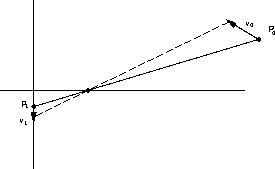Introduction



Next: Generation of Optical
Up: Motion Flow in Computer
Previous: Motion Flow in Computer
Until now we dealt primarily with single image and the type of
information encoded in it as well as with the means how to extract it. In
some evolutionary circles, it is believed that the estimation of the motion
of predators advancing at a mobile animal was important to its ability to
take flight away from the predator and hence survive. In this lecture, we
will deal with the problem of recovering the motion of objects in the 3-D
world from the motion of segments on the 2-D image plane.
The technical problem with estimating the motion of objects in 3-D is that
in the image formation process, due to the perspective projection of the
3-D world onto the 2-D image plane, some of the information is lost. We
will now address several ways of recovering the 3-D information from 2-D
images using various ``cues''. These cues are motion, binocular
stereopsis, texture, shading and contour. In this lecture we will
content ourselves with studying motion flow.
If the projection of a 3-D point on the image plane is a point with image
coordinates  , simple inversion of the perspective projection
equation in order to obtain 3-D information will not work, since there are
infinitely many points in the 3-D which would get projected to the same
point
, simple inversion of the perspective projection
equation in order to obtain 3-D information will not work, since there are
infinitely many points in the 3-D which would get projected to the same
point  in the image plane, all lying on a line going through the
center of projection and the point
in the image plane, all lying on a line going through the
center of projection and the point  (see Figure 1). Thus, some additional
information is needed in order to recover the 3-D structure from 2-D
images. One possible way how to extract this 3-D information is from
time-varying sequences. This 3-D information crucial for performing
certain task, such as manipulation, navigation, recognition.
(see Figure 1). Thus, some additional
information is needed in order to recover the 3-D structure from 2-D
images. One possible way how to extract this 3-D information is from
time-varying sequences. This 3-D information crucial for performing
certain task, such as manipulation, navigation, recognition.

Figure 1: Displacement of a point in the environment causes a displacement
of the corresponding image point. The relationship between the
velocities can be found by differentiating the perspective
projection equation.
For more details see (B. Horn, ``Robot Vision'',
MIT Press, 1986, Chapter 12, Chapter 17)
There is lot of biological motivation for studying motion flow
(besides being eaten by sabre toothed tigers, that is):
- Human beings do it all the time without even realizing it,
for example, this is why we have
saccadic eye movements (that is our eyes jump from focusing at one
spot to another). Thus, if the scene has no motion,
and we are still our eyes are moving. There are celebrated experiments
made on the movements of the pupils of people looking at the Mona Lisa
for instance showing the eyes darting from the eyes to the lips to
the mouth and then the hair and so on.
- Simple experiment can demonstrate how motion can reveal something
about the 3-D structure. Fixating on something close and very far away and
moving your head (either sideways or forward and backward), you can notice
that the retinal image of the close by tree moves more then the one
of a distant tree, i.e. the motion in the retinal plane is inversely
proportional to the distance from the retinal plane.
- There are a few examples from the animal world, where the motion helps
the animals to obtain some information about the environment structure,
e.g. pigeons move their necks to get the so called ``motion parallax''.



Next: Generation of Optical
Up: Motion Flow in Computer
Previous: Motion Flow in Computer
S Sastry
Sun May 5 23:42:22 PDT 1996
 , simple inversion of the perspective projection
equation in order to obtain 3-D information will not work, since there are
infinitely many points in the 3-D which would get projected to the same
point
, simple inversion of the perspective projection
equation in order to obtain 3-D information will not work, since there are
infinitely many points in the 3-D which would get projected to the same
point  in the image plane, all lying on a line going through the
center of projection and the point
in the image plane, all lying on a line going through the
center of projection and the point  (see Figure 1). Thus, some additional
information is needed in order to recover the 3-D structure from 2-D
images. One possible way how to extract this 3-D information is from
time-varying sequences. This 3-D information crucial for performing
certain task, such as manipulation, navigation, recognition.
(see Figure 1). Thus, some additional
information is needed in order to recover the 3-D structure from 2-D
images. One possible way how to extract this 3-D information is from
time-varying sequences. This 3-D information crucial for performing
certain task, such as manipulation, navigation, recognition.
